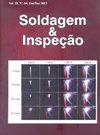Analysis of Interlayer Idle Time as a Temperature Control Technique in Additive Manufacturing of Thick Walls by Means of CMT and CMT Pulse Welding Processes
IF 0.3
4区 材料科学
Q4 METALLURGY & METALLURGICAL ENGINEERING
引用次数: 11
Abstract
Abstract: Inserted in the scenario of innovations and technological trends of Industry 4.0, this work aims to obtain detailed knowledge on the influence of idle time between layers as thermal control technique for the Wire Arc Additive Manufacturing (WAAM) with two GMAW process variants of high controllability (CMT and CMT Pulse). The problem focuses on the deposition of thick walls, seeking to emulate the challenges of manufacturing big parts with medium geometric complexity, such as propellers and screws, which usually have sections of this thickness. Although works in the area of additive manufacturing point out the use of idle time as a feature to stabilize the thermal gradient, detailed information about the thermal behavior ends up being omitted. Both processes variants used presented high metallic transference stability and low thermal input when compared to the conventional GMAW, being positive differentials for WAAM. In the tests, walls with eight layers were built with ER309LSi steel in which the interlayer idle time varied from 0 to 300 s. It can be concluded that both processes are WAAM compliant, and that although the CMT Pulse has a higher energy input, the temperature control by idle time was able to control the thermal accumulation in the part for both processes.CMT和CMT脉冲焊接增材制造厚壁层间空闲时间温度控制技术分析
摘要:在工业4.0创新和技术趋势的背景下,本工作旨在获得层间空闲时间作为热控制技术对具有高可控性的两种GMAW工艺变体(CMT和CMT脉冲)的线弧增材制造(WAAM)的影响的详细知识。这个问题集中在厚壁的沉积上,试图模拟制造中等几何复杂性的大型部件的挑战,比如螺旋桨和螺钉,它们通常有这种厚度的部分。尽管增材制造领域的工作指出,利用空闲时间作为稳定热梯度的特征,但有关热行为的详细信息最终被省略。与传统的GMAW相比,所使用的两种工艺变体都具有高的金属转移稳定性和低的热输入,这是WAAM的积极差异。试验采用ER309LSi钢砌筑8层墙体,层间空闲时间为0 ~ 300 s。可以得出,两种工艺都是WAAM柔性的,虽然CMT脉冲具有较高的能量输入,但通过空闲时间控制温度能够控制两种工艺的零件热积累。
本文章由计算机程序翻译,如有差异,请以英文原文为准。
求助全文
约1分钟内获得全文
求助全文
来源期刊

Soldagem & Inspecao
工程技术-冶金工程
CiteScore
1.00
自引率
16.70%
发文量
13
审稿时长
12 weeks
期刊介绍:
The Journal Soldagem & Inspeção (S&I) js a techno-scientific journal created in 1995. Printed issues of this journal are distributed free of charge to libraries in Brazil, Latin America and the Iberian Peninsula. It has been printed regularly every quarter since September, 2002, and, since the beginning of 2007, its electronic version is available in the address: (http://www.abs-soldagem.org.br/s&i/). The journal is sponsored by the Brazilian Welding Association (ABS).
Since its creation several well known professionals working in welding contributed with the Journal Soldagem & Inspeção and its editorial board crosses the Brazilian borders. During its evolution the Journal received ta special contribution from the Editors-in-chief : Ronaldo Paranhos, Américo Scoti, Paulo Modenesi e Alexandre Bracarence. Since January 2012 the Editor-in-chief is Ana Sofia C. M. D’Oliveira, Full professor at Universidade Federal do Paraná (UFPR) . Her work focus mainly on Hardfacing and Physical Metallurgy. The jornal Soldagem & Inspeção also counts with 10 Associate Editors and a fix Editorial board of referees. short-term (Ad Hoc) referees can be invited to evaluate some papers submitted to the journal.
The Soldagem & Inspeção journal is the scientific divulgation channel of the Brazilian Welding Association (ABS). It aims to publish original papers related to the scientific and technological development of welding, inspection, and related fields. Review papers or letters on current and controversial subjects are also published in the Journal.
Its abbreviated title is Soldag. insp. (Impr.), which should be used in bibliographies, footnotes and bibliographical references and strips.
 求助内容:
求助内容: 应助结果提醒方式:
应助结果提醒方式:


